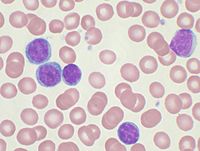
Photo from wikipedia
Purpose: B-cell receptor (BCR) signaling is critical for the pathogenesis of chronic lymphocytic leukemia (CLL), promoting both malignant cell survival and disease progression. Although vital, understanding of the wider signaling… Click to show full abstract
Purpose: B-cell receptor (BCR) signaling is critical for the pathogenesis of chronic lymphocytic leukemia (CLL), promoting both malignant cell survival and disease progression. Although vital, understanding of the wider signaling network associated with malignant BCR stimulation is poor. This is relevant with respect to potential changes in response to therapy, particularly involving kinase inhibitors. In the current study, we describe a novel high-resolution approach to investigate BCR signaling in primary CLL cells and track the influence of therapy on signaling response. Experimental Design: A kinobead/mass spectrometry–based protocol was used to study BCR signaling in primary CLL cells. Longitudinal analysis of samples donated by clinical trial patients was used to investigate the impact of chemoimmunotherapy and ibrutinib on signaling following surface IgM engagement. Complementary Nanostring and immunoblotting analysis was used to verify our findings. Results: Our protocol isolated a unique, patient-specific signature of over 30 kinases from BCR-stimulated CLL cells. This signature was associated with 13 distinct Kyoto Encyclopedia of Genes and Genomes pathways and showed significant change in cells from treatment-naïve patients compared with those from patients who had previously undergone therapy. This change was validated by longitudinal analysis of clinical trials samples where BCR-induced kinome responses in CLL cells altered between baseline and disease progression in patients failing chemoimmunotherapy and between baseline and treatment in patients taking ibrutinib. Conclusions: These data comprise the first comprehensive proteomic investigation of the BCR signaling response within CLL cells and reveal unique evidence that these cells undergo adaptive reprogramming of this signaling in response to therapy.
Journal Title: Clinical Cancer Research
Year Published: 2021
Link to full text (if available)
Share on Social Media: Sign Up to like & get
recommendations!